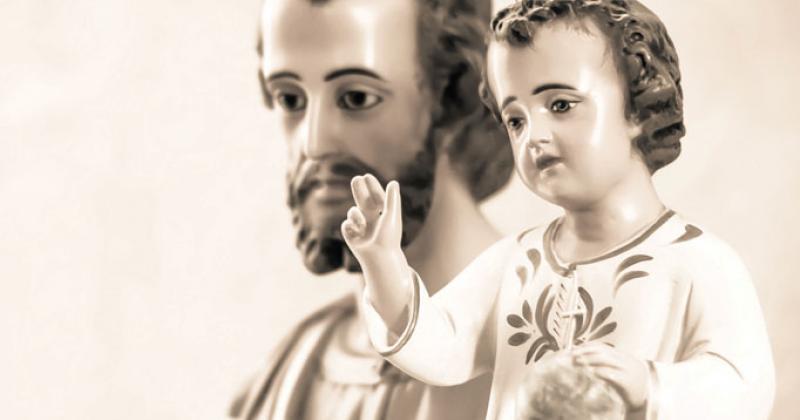With the 100th anniversary of Fatima, many people have heard about the “Miracle of the Sun” in the October 1917 apparition. But few realize that St. Joseph appeared in that vision.
Servant of God Lucia Santos, the longest living visionary of Fatima, described the blessed appearance in her Memoirs: “After Our Lady had disappeared into the immense distance of the firmament, we beheld St. Joseph with the Child Jesus and Our Lady robed in white with a blue mantle, beside the sun. St. Joseph and the Child Jesus seemed to bless the world, for they traced the Sign of the Cross with their hands.”
“It reiterates the importance of St. Joseph’s role within the Church,” explained Mike Wick, executive director of the Institute on Religious Life, of St. Joseph’s appearance. As a husband and father, Wick finds that St. Joseph’s presence in the apparition “says so much for our world today. He’s the silent giant, the forgotten friend who is constantly present.”
In Corcoran, Minnesota, Brian Holt looks to St. Joseph as a model for being a husband and father. He and his wife, Marylou, have eight children ranging in age from 8 to 26.
“My favorite daily prayer for years before work is the ‘Workman’s Prayer to St. Joseph,’” Holt said, adding that the family also prays the Rosary ahead of home-schooling each day.
Holt has been trying to follow Joseph’s saintly example when teaching work skills to his children, too. For this year’s winter project, he worked with three of his sons in remodeling a part of their home. “I’m teaching them skills so that when they’re heads of their own families, they can take care of themselves,” explained Holt, who builds furniture, too. “The skills, the health and motivation comes from God. The ability to serve comes from God. To have work to do is a blessing.”
Wick said his favorite title for Joseph is “patron of the present moment” — to live the present moment taking on the grace God gives you to fulfill the duty and the vocation you’re called, “quietly and subtly as Joseph did.”
The Holy Family’s presence at the last Fatima apparition is a timely reminder for today’s families, believes Wick. “We need this today in families — the reflection of what the Church is to be, the family of God. Joseph being head of the Holy Family gives us great instruction to what God’s plan is to be.”
“St. Joseph was teaching and reflecting the image of the fatherhood of God” in his role as head of the Holy Family, Wick added.
Thus, Fatima, for all of its other meanings, also is a reminder of the importance of fatherhood.
“The fatherhood of St. Joseph, as with all human fathers, is a reflection in a creature of the fatherhood of God the Father,” emphasized Msgr. Joseph Cirrincione in his 1989 booklet St. Joseph, Fatima and Fatherhood. “[T]he vision of St. Joseph and the Infant Jesus blessing the world, with Mary by the side of the sun, which has not left its place, is God’s assurance that although man may reject him, God will never reject man.”
When the peaceful family scene is disrupted by the sun’s gyrations during the Miracle of the Sun, Msgr. Cirrincione sees “an ominous foreshadowing of the consequences for the world, which are sure to be felt if the true fatherhood of God and the traditional strong role of the father of the family are rejected by mankind.”
He added: “The Miracle of the Sun represents not so much a threat of evils to come as it does a foreshadowing of the dethronement of God the Father and an intimation of the appalling consequences to follow.”
Msgr. Cirrincione explained, “Since human fatherhood, as a reflection of the fatherhood of God, was designed to be the pillar of the family, the disappearance of esteem for fatherhood has led to the collapse of that pillar and to the disintegration of the family.”
Wick agreed: “The presence of Joseph especially at Fatima is a reminder God the Father is looking for us, waiting for us to return to the Lord. Joseph, just like Mary, plays the part of the missionary.”
Looking to St. Joseph, the patron of the universal Church, is key for his March feast day and beyond — as Pope Leo XIII reminded the faithful.
Pope Leo XIII consecrated October to Our Lady of the Rosary — the title Mary would later call herself at Fatima — and in his 1889 encyclical Quamquam Pluries (Devotion to St. Joseph), Pope Leo asked “for the Christian people continually to invoke, with great piety and trust, together with the Virgin Mother of God, her chaste Spouse, the Blessed Joseph.”
Because it was of “high importance that the devotion to St. Joseph” was included in the daily practices of Catholics, Leo prescribed and provided a prayer to St. Joseph to be recited after the Rosary during October (see sidebar).
Keeping the holy example of St. Joseph in mind is a key part of Catholic devotion.
As Pope Leo wrote: “The Blessed Patriarch looks upon the multitude of Christians who make up the Church as confided specially to his trust — this limitless family spread over the earth, over which, because he is the spouse of Mary and the father of Jesus Christ, he holds, as it were, a paternal authority.
“It is, then, natural and worthy that as the Blessed Joseph ministered to all the needs of the family at Nazareth and girt it about with his protection, he should now cover with the cloak of his heavenly patronage and defend the Church of Jesus Christ.”
In his book True Story of Fatima, Father John DeMarchi believes similarly, stating, “Our Lord did not come to destroy, but to save. He saved the world that day through the blessing of good St. Joseph and the love of the Immaculate Heart of Mary for her children on earth.”
